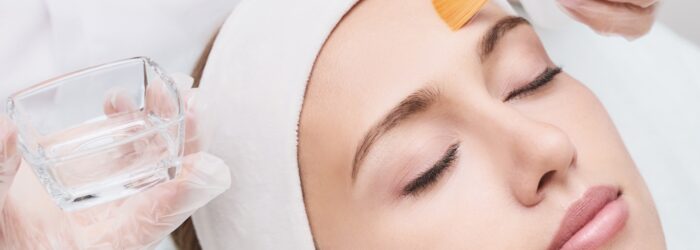
Peeling Face and Hands
Peeling is a treatment intended for both men and women.
Chemical peels lighten the complexion and make it more even, hide imperfections, tighten dilated pores, erase brown spots from the skin, fill in small lines, smooth any roughness, reduce acne scars and retentional lesions (blackheads).
The chemical action of the peel destroys the cells of the epidermis and of the superficial layers of the dermis in a restricted, controlled way which makes it regenerate and produce new cells.
According to the desired level of skin depth, it is used for the simple ablation of the stratum corneum (boost in radiance) to the complete regeneration of the epidermis or dermis by stimulating the synthesis of skin cells.
Peeling can be applied to the face, the hands, and the décolleté, and can be combined with a LED light treatment.
There are different types of chemical peel adapted to each expectation and each skin
- Superficial peeling : based on fruit acid, it is light, simple and effective and suitable for young skin. Glycolic acid peeling is the most often used. Ideal for mixed to greasy skin, it cleans up all imperfections, tightens dilated pores, and leaves the skin soft and smooth, with a healthy glow, free of blackheads and an even complexion. No downtime is required.
- Medium peel or TCA peel (trichloracetic acid) : for skin that is more mature. It is recommended for small lines, scars and melasma (mask of pregnancy). It causes redness and flaking requiring downtime of a few days.
Indications :
Heliodermia, photo ageing (ageing of the skin caused by the sun), lentigo, actinic keratosis, altered complexion, wrinkles, lines
Hyperpigmentation, melasma (or chloasma or mask of pregnancy)
Scarring
Simple or retentional acne
Recommendations before the treatment
15 days before the treatment and between the sessions, the application of a specific cream is recommended morning and night to prepare the skin.
7 days before the peeling, stop taking retinoic medication (for acne) and stop hair removal on the area to be treated.
It is advisable to avoid shaving the area to be treated 2 hours before the procedure.
It is not recommended to proceed to peel tanned skin.
How a session takes place
In a doctor’s surgery without the need for prior anaesthetics.
After a detailed examination and diagnostic, a personalised programme is established depending on your expectations and skin type.
Recommendations after the session
Avoid exposure to the sun or UV rays during the treatment and one month after the last session.
The results
The treatment normally takes 3 to 4 sessions at 15-day intervals.
The results can be seen from the first session.
Contraindications
- Known allergy to the product
- Roaccutane or other acne medication
- Pregnancy and breast feeding
- Herpes at the level of the area to be treated
Side effects of peeling
Expected, benign side effects :
- Skin that peels
- Redness and crusts can last from one to two weeks
- Sensation of burning and tight skin
Side effects of low concern :
- Hyperpigmentation/hypopigmentation
- Skin infection
- Scarring problem: keloids